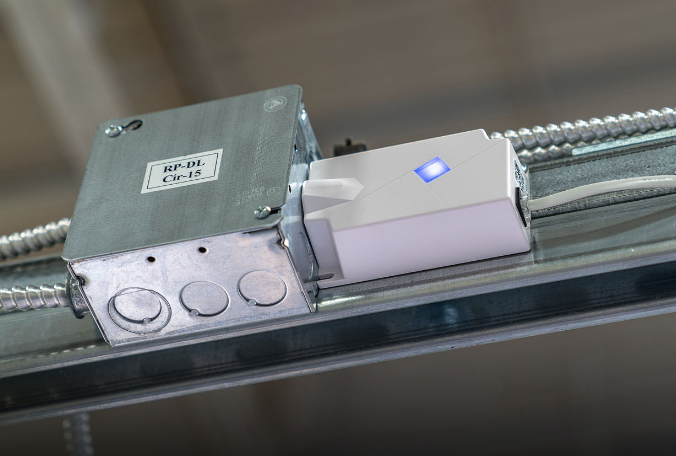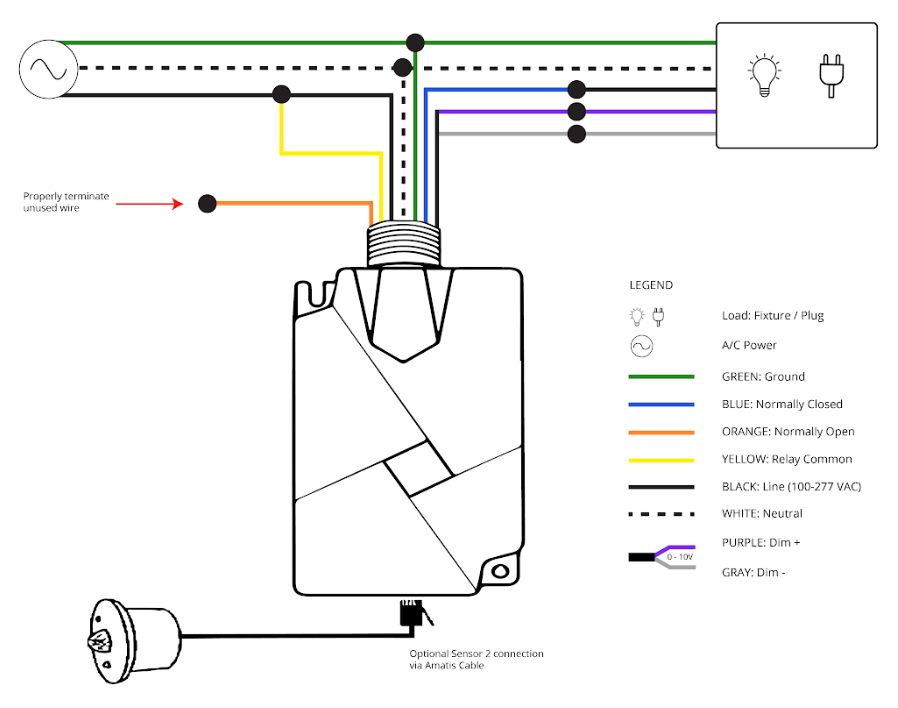LUUM.IO
ADVANCED LOAD CONTROLLER (ALC) - INSTALL GUIDE#

Introduction#
About This Guide#
This guide provides instructions for installing the Advanced Load Controller (ALC), an Amatis wireless load controller. In addition to the step-by-step installation process, this guide provides instructions on how to configure the ALC, as well as some basic troubleshooting steps.
Product Overview#
The Advanced Load Controller (ALC) is a wireless fixture or load controller, offering features like 0-10V dimming control, power monitoring, and energy management. It connects to wireless networks via the Amatis Border Router (AMBR) and includes an RJ12 port for environmental monitoring with a Sensor2 (not included), which tracks occupancy, light levels, temperature, and humidity.
- Up to 20A relay for load switching.
- 0-10V output for dimming of one or more drivers.
- RJ12 port for add-on environmental sensor.
- Energy consumption tracking and detection of failed drivers or lamps.
- Cloud connection via AMBR, uploading real-time data from your site to the Amatis config app.
Installation#
Parts List#
Before getting started with the installation process, it's important to make sure all the necessary components are included. Here's what should be found inside the box:
- (1) Advanced Load Controller (ALC)
- (4) Wire Nuts
Placement#
Follow these guidelines when deciding on where to install the ALC:
- The ALC should be installed on a junction box or other electrical enclosure to manage the wire connections.
- If a Sensor2 is going to be used, the ALC should be installed within 3' of the sensor, or 20' with an extension cable (not included).
-
The ALC should be installed within 200' of an AMBR or other wireless node.
Distance Limitations
The Amatis system supports communication ranges up to 200' (does not apply to wall switches) with a clear line of site. Obstacles such as walls or floors will impact the communication ranges significantly.
Wiring#
Follow the wiring diagram to connect the Advanced Load Controller:

Note
Some ALCs only have two red relay wires instead of the three orange, blue, and yellow relay wires shown in the diagram. In this case, the ALC functions as a normally closed relay, and either red wire can be used as the common.
Labeling & MAC Capture#
After installing any Amatis wireless device, it is imperative to note the device ID with the associated load/fixture/device. This is how the devices will be identified in the programmed. It is also a good idea to label any Amatis load controllers with the load they are controlling.
Note
The device ID can be found on the device’s packaging or the device itself.
Initial Setup#
Necessary Parts#
Review the following list to ensure all necessary parts are available:
- An active AMBR within communication range of the ALC.
- Active power to the ALC.
Device Configuration#
Perform the following steps to configure the device:
- Open up the Amatis App and navigate to the site.
- Open the Devices table and ensure a device with the ID noted in the previous step is active.
The device is now ready to be added to a location and programmed with the Amatis App.
Load/Fixture Control#
When the ALC is being used for load or fixture control, no additional consideration is needed. The device can be put into locations/zones and programmed.
Plug Load Control#
When the ALC is being used for control of receptacles, it is highly recommended the device be put into a separate plug load zone in the location. This will allow for special programming considerations to be applied to the plug load.
Note
The Amatis system meets automatic receptacle control requirements for California Title 24 and ASHRAE 90.1 2016.
Updating Firmware#
Perform the following steps to update the device's firmware:
- Open up the Amatis App and navigate to the site.
- Open the Devices table and find the device to be updated.
- Make sure the "Firmware Version" column is visible. If the firmware is out of date, it will show a yellow alert and yellow text.
-
Click on the out of date firmware to request a firmware update.

Note
Depending on how out of date the firmware is, the programming may need to be synced to the devices after a firmware update.
Related Information#
Basic Troubleshooting#
Perform the following steps for basic troubleshooting of the device:
- Verify the device is operating normally using the LED Troubleshooting Matrix below.
- Verify the load is being switched by pressing the device button. This should toggle the load on and off, and the relay should make an audible click.
- Power cycle the device by turning off the circuit, and turning it back on 30 seconds later.
LED Indicator Troubleshooting#
Use the following table to troubleshoot specific issues with the device based on the LED indicators:
| LED Troubleshooting Matrix | |||
|---|---|---|---|
| LED Color | SOLID | FLASHING | OFF |
| Blue | Device communicating normally | Device unable to communicate with an AMBR | No power to device |
Normal Operation
BOLD description indicates normal operation.
Button Operation#
On the top of the ALC, there is a button that also functions as the indicator LED.
| Button Operation | |
|---|---|
| PRESSES | BEHAVIOR |
| 1 Press | Toggle the relay on or off |
| 10 Press | Set the device to the default network profile |
Technical Support#
If you experience any issues during installation or operation of this product, please contact our technical support team for assistance. Our technical support team is available via email at support@amatiscontrols.com. Please provide a detailed description of the issue you are experiencing, including any error messages or other relevant information.
Warranty#
All Amatis LED lighting products and controls come with a 5-year parts warranty, as well as labor per product up to a maximum of 50% of the material price for parts being replaced*. All parts are UL certified. Lamps are DLC certified, therefore eligible for utility incentives. We warrant that our products will be free from defects in material and workmanship for a 5-year period from the date of purchase. Defective products under warranty will be replaced with an equal or higher quality product.
Internet Connection
The Amatis Border Router (AMBR) connected to your affected device must have remained connected to the Amatis cloud via the Internet or cellular connection from the start of site commissioning to date of return request. Non-connected systems are eligible for a 2-year limited warranty (730 days) from shipment date, with the same remaining criteria.
Contacts#
Luum.io Headquarters
625 Kenmoor Ave STE 350
PMB 51933
Grand Rapids, MI. 49546
Phone: +1 (313) 314-3617
Document Feedback#
While we have taken great care to ensure the accuracy and completeness of this document, we welcome your feedback and suggestions to further improve it. If you notice any errors or omissions or feel that a topic could benefit from further explanation, please let us know by emailing your feedback to support@amatiscontrols.io. Your input is valuable to us and will help us enhance the quality and usefulness of our documentation.
Disclaimer#
All rights, title, and interest in and to this manual, including without limitation all copyright, trademark, patent, trade secret, and other proprietary rights, belong solely and exclusively to Luum.io and/or its licensors. This manual is provided solely for the purpose of assisting in the installation and operation of the device, and no license or other rights are granted or implied hereby. No part of this manual may be reproduced, distributed, or transmitted in any form or by any means, including photocopying, recording, or other electronic or mechanical methods, without the prior written permission of Luum.io. The contents of this manual are subject to change without notice. The information contained herein is provided on an 'as is' basis and is for informational purposes only. Luum.io makes no warranty, express or implied, as to the accuracy, completeness, or usefulness of this information, nor does it assume any legal liability or responsibility for the consequences of any errors or omissions therein. The names of actual companies and products mentioned herein may be the trademarks of their respective owners.